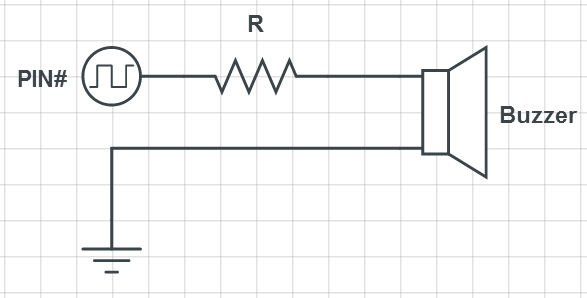This is a simple sound library for mbed. This sound library uses a Ticker to simulate a 50% duty cycle pwm signal on any pin. The frequency of this signal can be varied to allow sound to be created by any piezoelectric device that is connected to that pin.
Dependents: SuperMbedBall Tono
About
This library allows for a buzzer (or piezoelectric device) to output sound based on any inputted frequency. The library provides predefined note frequencies which make song writing convenient. These definitions can be found here. Some pins may not be able to drive output such as the AnalogIn pins on the LPC11U24 model. Only pin 21 seemed to work well so far on this model.
Hardware
One wire from a buzzer is connected to any pin on the mbed and the other wire is connected directly to ground. To reduce the volume of the buzzer, an optional resistor can be connected in series as shown.

Circuit diagram constructed using CircuitLab.
Usage
A music object is constructed in the following way:
Constructor
#include "Music.h" music ms(p21);
This code snipped attaches a frequency modulating Ticker to the specified pin.
This frequency can be modified by setting:
Frequency
ms.freq(240);
To allow more complex behavior, a parsing function is included that can take in strings of formatted input and turn them into songs. This input must be formatted as specified below:
- A capital letter must be present to specify the note, or R to specify a rest (Only letters A-G, and R are valid)
- An octave must be specified which is any integer from 0 to 8 inclusive
- An optional sharp sign ( # ) can be added to augment the note a half step
- A colon ( : ) must separate the octave and note from the duration
- The duration must be an integer greater than 0, and less than or equal to 64
- To separate notes, a semicolon ( ; ) must be used
Furthermore, the length of the string must be specified in order for the entire string to be parsed and a tempo must be provided (beats per minute). An example of this is shown below:
Play a Song
/* This is a test song */ char s1[] = "E4:8; E4:8; R:8; E4:8; R:8; C4:8; E4:4; G4:4; R:4; G3:4; R:4;"; int len = 61; /* Set up music pin on pin 21 */ music m1(p21); double tempo = 180; m1.play(s1,tempo,len);
This code plays the familiar 7-note opening to the Super Mario Brothers theme song. The possibilities for music creation are limited only by the hard memory limits of the mbed.